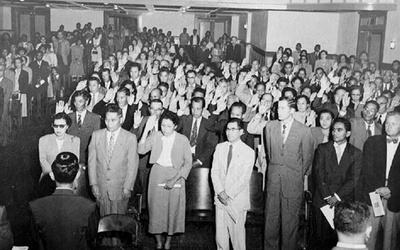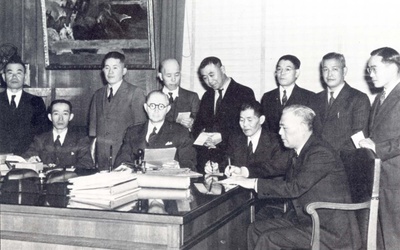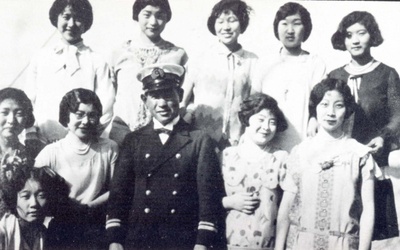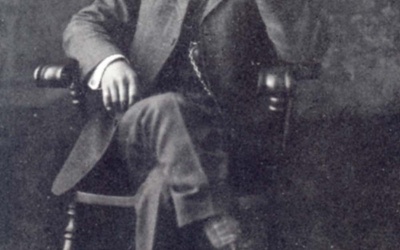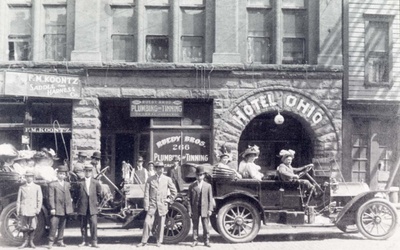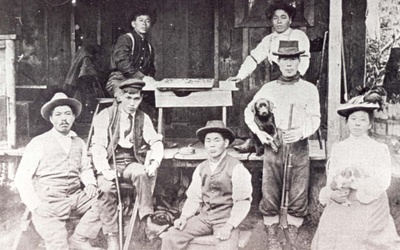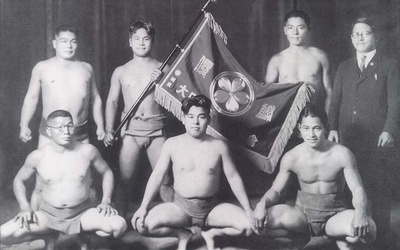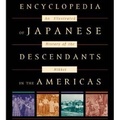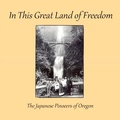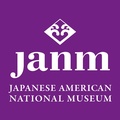
Eiichiro Azuma
Eiichiro Azuma is the Alan Charles Kors Term Chair Associate Professor of History and Asian American Studies at University of Pennsylvania. He is author of Between Two Empires: Race, History, and Transnationalism in Japanese America (Oxford University Press, 2005) and co-editor of Yuji Ichioka, Before Internment: Essays in Prewar Japanese American History (Stanford University Press, 2006). Professor Azuma is also currently at work with David Yoo in the editing of the Oxford Handbook of Asian American History. Between 1992 and 2000, he worked as a Curator/Researcher at the Japanese American National Museum and has an MA in Asian American studies and a PhD in history from UCLA.
Updated July 2013
Stories from This Author
Chapter 8 — Renewed Oppression and Final Struggle
Dec. 11, 2017 • Eiichiro Azuma
Once he was our friendThe owner of the store nowBehaves nervouslyRefusing to sell us goods Shizue Iwatsuki1 With the war coming to an end, Oregon experienced renewed anti-Japanese movements. In Gresham, local farmers and businessmen, inspired by the economic advantage of Japanese exclusion, started a campaign to prevent their return as early as 1943. This movement led to the establishment of the Oregon Anti-Japanese Inc., in November, 1944. Later renamed the Japanese Exclusion League, this group called for “the enactment …
Chapter 7 — Issei Life Behind Barbed Wire
Dec. 5, 2017 • Eiichiro Azuma
The harsh winds of autumnPierce the spirit of thoseWho live at the mercy of fateCreated by the war. Akiyama1 The internees had primitive living conditions. The North Portland Assembly Center had previously been used as the Pacific International Livestock Exposition Building and was barely adapted for human habitation. Each family was assigned to a small, single room in a large barrack with walls made of thin plywood sheets. In order to make each room as “homey” as possible, the internees …
Chapter 6 — Pearl Harbor: Days of Anguish and Confusion
Nov. 27, 2017 • Eiichiro Azuma
We have spent two-thirds of our lives in the United States and we feel we are more American than Japanese; we are willing to do anything we may be asked to do to help our foster mother. A Portland Issei, January 23, 19421 Japan’s attack on Pearl Harbor had a profound impact on Issei life. Immediately classified as “enemy aliens,” they were no longer able to assure security for themselves or for their children. “Asleep or awake, I felt as …
Chapter 5 — The Struggle Against Exclusion
Nov. 20, 2017 • Eiichiro Azuma
A series of exclusionsNow getting used to itI spend each day farming Honda Fugetsu1 While building their community and industries, Japanese immigrants struggled against exclusionists’ threats. Combined with the rise of anti-foreign sentiments of World War I, the rapid growth of Issei agriculture stirred whites’ fear of Japanese competition. As the Hood River Japanese farmers showed a notable prosperity with a high level of land ownership, they became the prime target of organized exclusionist attacks. The local American Legion was …
Chapter 4 — Japanese Immigrant Families and Community Development
Nov. 13, 2017 • Eiichiro Azuma
“Japan is such a small island country…. What is the use of returning to such a place? If we have to fulfill our filial duty to parents and live with wives, why don’t we have them come to America? If the difference in the language and customs bothers us, why don’t we learn to adapt to them”1 Masuo Yasui The rapid development of Japanese farm communities in Oregon was marked by the emergence of families. The early Japanese immigrant society …
Chapter 3 — Development of Japanese Farming Communities
Nov. 6, 2017 • Eiichiro Azuma
The untouched ground of AmericaI began to hoeThis virgin soil. Honda Fugetsu1 During the 1900s, many Japanese immigrants moved into agricultural work. At first, the Issei were drawn by better wages to work on farms. In 1909, farm laborers represented more than a quarter of the total 3,873 Japanese in Oregon. Known as buranke katsugi [blanket carriers], they were seasonal migrants, carrying blankets with a few other daily necessities. Many of these men subsequently invested their earnings and rose above …
Chapter 2 — Early Japanese Life in Oregon
Oct. 30, 2017 • Eiichiro Azuma
Working as a hop pickerIt is impossible toReturn to Japan Honda Fugetsu1 Before 1910, the majority of the Oregon Japanese population were male laborers who lived in a crude environment. Initially, most, if not all of them came to America not to settle, but to work and make money for their families in Japan. For these people, Portland was a temporary home to which they returned when they completed seasonal work. Until they found their next jobs, they stayed at …
Chapter 1 — The Issei Arrive in Oregon
Oct. 23, 2017 • Eiichiro Azuma
The History of the Issei Pioneers in Oregon, 1880 – 1952 Between 1843 and 1860, more than 250,000 pioneers began the journey across the Oregon Trail heading west. In 1859, Oregon became one of the United States and was still a young state with undeveloped forests and virgin farmlands when the Japanese immigrants arrived in the 1880s. Called Issei, the first generation, Japanese immigrants, like all pioneers, struggled to survive in their new environment. Unlike most other immigrants, the Issei …
Issei in New York, 1876 – 1941
July 7, 2014 • Eiichiro Azuma
The first Japanese immigrants to New York were quite different from their West Coast counterparts. Initially, the majority of Issei (first generation Japanese in America) came to New York, not to make quick money and return to Japan, but to engage in U.S.-Japan trade and learn Western ways. Many of these New York Issei came from Tokyo and other large cities, rather than from farming prefectures. Japanese Entrepreneurs The first Japanese in New York were ambitious young businessmen. In 1875, …
Japanese American Sumo in the Continental United States, 1900-1941 - Part 2
March 28, 2014 • Eiichiro Azuma
Read Part 1 >>Japanese American Sumo in the New Era: From Issei to Nisei The 1924 Immigration Act was an important turning point in the history of Japanese Americans. With the termination of new Japanese immigration and the exodus of many Issei, the population of first generation immigrants decreased rapidly, and the average age of the Nikkei drastically changed. By 1930, the second generation made up more than 50 percent of the entire Japanese American population. While the majority of …

